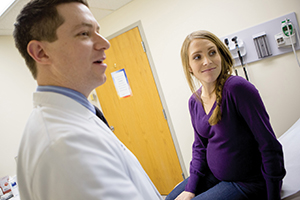By COLLEEN SCHRAPPEN
About one in 10 women has trouble getting or staying pregnant, according to the Centers for Disease Control and Prevention. Options — and opinions — on how to treat infertility are not in short supply, but not all of them are in keeping with Catholic teachings on reproductive medicine.
Mercy Hospital St. Louis recently began offering an approach to fertility treatment called Natural Procreative Technology. Brian O'Toole, senior vice president of mission and ethics for the Mercy health system, says NaPro is compatible with the Ethical and Religious Directives for Catholic Health Care Services. NaPro originated in Omaha, Neb., at the Pope Paul VI Institute for the Study of Human Reproduction and the National Center for Women's Health. The system, developed more than a decade ago by the center's director, Dr. Thomas Hilgers, is not widely employed.

Dr. Gavin Puthoff reviews an ultrasound scan of her pregnancy with Celeste Olsen. Puthoff practices a natural alternative to more medically intensive fertility treatments. Olsen had a son early last month.
Only 20 doctors in the United States have trained directly under Hilgers. Among them is Dr. Gavin Puthoff, an ob-gyn who completed his residency at Mercy Hospital St. Louis in 2014. Puthoff says he pursued a postresidency fellowship with Hilgers because he wanted to approach his medical practice in a way that aligned with his Catholic religious beliefs.
Puthoff returned to St. Louis from the Paul VI Institute in August. He opened a fertility clinic on the suburban campus of Mercy Hospital. By the end of 2015, he had seen more than 100 new patients who had been referred to him by another fertility care center or had found out about his approach via word of mouth.
O'Toole says of NaPro: "Here's a method to help women challenged by fertility. Here's a way of naturally working with your body — working with God, so to speak.
"It's always part of the heritage of a Catholic hospital to help women conceive and plan their families in accordance with Catholic teaching," says O'Toole. Specifically, that means no use of artificial contraceptives and no artificial means of fertility treatments, including insemination and in vitro fertilization.
For Puthoff, following the teachings of the church in his medical practice made sense not just for him, but also for his patients. "A big part of why I went into ob-gyn is I wanted to offer patients an alternative to prescribing birth control" in treatment of medical issues. Puthoff says while birth control hormones can be effective in treating painful and abnormal symptoms related to a woman's reproductive cycle, the hormones may give symptom relief without treating the underlying problem. The NaPro model addresses medical issues such as endometriosis or hormonal imbalance.
Cure versus symptom control
When Puthoff sees a new patient, he explains the foundation of the NaPro approach: the Creighton Model FertilityCare System, a method of tracking a woman's reproductive cycle.
"It helps the patient understand her body more and when her fertile time is," Puthoff says. The patient keeps a daily log, noting changes in biomarkers associated with her reproductive cycle.
After a couple of months, Puthoff can use those biomarker logs, along with ultrasounds and blood tests, as diagnostic tools to identify the underlying cause for infertility.
At that point, the patient may be prescribed medicine or given hormones, or she may need surgery.
Promoting fertility
Because NaPro treatments are for medical issues, such as endometriosis or blocked fallopian tubes, and not specifically for fertility, they are usually covered by a patient's insurance. A focus of the NaPro approach is to prevent the formation of scar tissue from surgery, which could hinder a woman's chance of getting pregnant. Excising a cyst, for example, may take a bit more time, because unlike in traditional surgery, the doctor sews the ovary back together.
According to Puthoff, an average patient has a 60 to 80 percent chance of getting pregnant within two years using the NaPro system. For in vitro fertilization, the chance of pregnancy is 25 to 35 percent with each cycle, or a 45 to 55 percent cumulative success rate after multiple cycles.
"And in vitro only treats the underlying (medical) issue about 10 percent of the time," Puthoff says. In comparison, with the NaPro method, "no matter what, you're healthier at the end of the trail."
Puthoff's patients have traveled from as far as 200 miles to see him. Not everyone is there to get pregnant; about 30 percent are seeing him for medical issues only.
But for those who are struggling to get pregnant, "this is exactly what they're looking for," he says — an approach that doesn't start with a medicine to induce ovulation, and go straight to IVF; an approach that empowers women to learn more about their bodies; an approach that treats underlying problems instead of masking them, Puthoff says.
"I didn't know how things would go when I started here," he says. But the demand has been steady, and a long-term goal is to spread the NaPro techniques through the Mercy system.
Extending access
In the spring of 2013, the Department of FertilityCare Services at Mercy Hospital installed telemedicine technology in its center to communicate with women in rural areas who wanted to learn about the Creighton Model, says nurse Diane Daly.
It's still a relatively small program, treating about 50 patients. But it's essential, says Daly, because it reaches women whose nearby doctors may not be well-versed in "the system of family medicine."
Daly and other staff work remotely with patients every couple of weeks to teach them how to use and understand the Creighton Model. "It improves their health care and opens up dialogue and communication," she says.
"This empowers women to be a part of their health care. People can live within their value system and still plan families effectively," Daly says.
Copyright © 2016 by the Catholic Health Association
of the United States
For reprint permission, contact Betty Crosby or call (314) 253-3477.